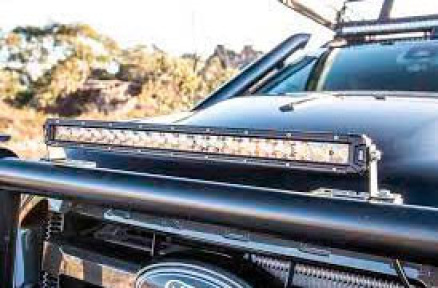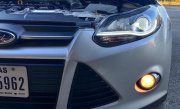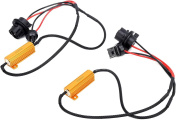
When it comes to enhancing your vehicle's lighting capabilities, one option that has gained immense popularity in recent years is the addition of LED light bars. These powerful illuminators improve visibility and give your ride a rugged and stylish look.
Size plays a vital role in determining the effectiveness of an LED light bar. Bigger is usually better in this case, as a larger light bar means more powerful illumination. A bigger light bar can cover a wider area, allowing you to see further and spot any potential obstacles or hazards on the road. So, if you're serious about upgrading your lighting game, consider a larger LED light bar.
But size isn't the only factor to consider. The shape of the light bar is also crucial. You'll find LED light bars available in various shapes, such as straight, curved, or even a combination of both. Each shape has its own advantages and is suited for different purposes.
Understanding Light Bar Sizes

When it comes to LED light bars, understanding their sizes is not as simple as buying a pair of shoes with a single number indicating the fit. In this case, size charts provide information about various parameters such as length, number of rows, shape, and more. These factors play a significant role in determining a light bar's appearance and performance.
Light Bar Length
One crucial aspect to consider is the length of the light bar. Different sizes are available to suit various needs and preferences. A wider light bar typically offers a broader beam spread, allowing for enhanced visibility over a wider area. It's important to select a length that fits well with your vehicle's dimensions and provides the coverage you desire.
Here are some of the best LED light bar brands and series for reference. Note how different manufacturers gravitate to different lengths for their products. This is not the only difference between them.
TOP-3 light bar brands, models, and their corresponding size ranges
|
Brand |
Model |
Size Range |
|
KC HiLites |
Gravity Pro6 LED Light Bar |
20"-57" |
|
Rough Country |
Black Series LED Light Bar |
6"-54" |
|
Rigid Industries |
Radiance Plus Series LED Light Bar |
10"-50" |
Number of Rows
Another important factor is the number of rows in the light bar. You'll come across options with single-row or dual-row configurations. The number of rows directly impacts the brightness and intensity of the light emitted. A single-row light bar is more compact and subtle in appearance, making it suitable for smaller vehicles or those who prefer a sleek look. On the other hand, a dual-row light bar provides increased brightness and coverage due to the additional row of LEDs, making it ideal for situations where maximum illumination is required.
The shape is another aspect that can influence the look and performance of a light bar. LED light bars are available in various shapes, such as straight, curved, or a combination of both. Each shape offers distinct advantages. Straight light bars emit a focused beam of light, providing long-range visibility. Curved light bars, on the other hand, offer a wider beam spread, illuminating a larger area. Some light bars even combine both straight and curved sections for a versatile lighting setup.
Another size specification you need to keep in mind is mounting. It's essential to consider other factors such as the mounting options and compatibility with your vehicle. Some light bars may require specific mounting equipment or modifications to ensure a proper fit. It's important to check the manufacturer's recommendations and guidelines to ensure a hassle-free installation.
How to Measure an LED Light Bar?

To accurately measure an LED light bar, follow these steps:
-
Prepare a tape measure. Get a measuring tape that is long enough to cover the entire length of your light bar.
-
Position the tape measure. Place the tape measure flat on the face or lens of the light bar. Make sure it is aligned with the edges of the light bar.
-
Measure the length. Starting from the edge where the light bar begins, extend the tape measure along the face of the light bar until you reach the edge where the light bar ends. Be careful not to include any mounting brackets in your measurement.
-
Read the measurement. Take note of the measurement indicated on the tape measure. This measurement represents the length of your LED light bar.
By measuring from the starting edge to the ending edge of the light bar, without including any mounting brackets, you can accurately determine the true length of the light bar itself. This method ensures that the dimensions you consider are specifically related to the size of the light bar.
What Do You Need to Install an LED Light Bar?

To install an LED light bar, you'll need the light bar itself, mounting brackets, wiring, nuts and bolts, a wiring harness (if not included, you can purchase one separately or create your own), and an in-line fuse for safety purposes.
When installing the light bar, follow the instructions provided by the manufacturer. Begin by mounting the brackets to your vehicle, ensuring they are securely fastened. Then, connect the wiring harness or wire the light bar directly to your vehicle's electrical system, making sure to follow proper electrical connections and ensuring the in-line fuse is in place.
Size Considerations for Optimal Visibility
Size does matter when it comes to LED light bars. A larger light bar generally translates to a wider beam spread, increasing visibility on the road. With a broader coverage area, you can better navigate dark and challenging conditions, ensuring a safer and more enjoyable driving experience.
However, it's important to strike a balance between size and practicality. While a massive light bar may seem enticing, it could obstruct other important components of your vehicle or create unnecessary drag. It's essential to select a size that fits well with your vehicle's overall design and dimensions. The goal is to achieve optimal visibility without compromising the functionality and aesthetics of your vehicle. By carefully considering the size of your LED light bar, taking into account local regulations, and evaluating your personal driving needs, you can make an informed decision that ensures enhanced visibility and a more enjoyable driving experience.
And don’t forget to familiarise yourself with any local regulations governing the use of auxiliary lights. Different jurisdictions may restrict the size and placement of LED light bars. It's crucial to ensure compliance with these regulations to avoid any legal issues or penalties.
Are Light Bars Legal?

The legality of using light bars on public roads is a topic that sparks considerable debate. While light bars are often encouraged for off-road use, employing them on public roads can pose serious safety concerns.
Mounting LED light bars on on-road registered vehicles are legally permitted in all 50 states. However, it's important to note that individual states have enacted their own laws and regulations regarding the use of these lights. This has resulted in some states declaring light bars illegal on public roads.
By adhering to state laws, you can ensure your driving experience remains safe and lawful. Remember, the primary purpose of these regulations is to protect both you and other road users, preventing unnecessary glare or distractions that may compromise road safety. So, before mounting that dazzling light bar on your vehicle, take the time to research and understand the specific laws applicable to your state.
Size & Power Consumption of Light Bars
In terms of power consumption, the wattage of a light bar reflects the amount of electrical power it requires to operate effectively. Higher wattage generally results in brighter output. For instance, a 30-inch LED light bar with 480 watts can produce an impressive 48,000 lumens of super bright light, ensuring excellent visibility in various conditions. Similarly, a 32-inch double-row LED light bar typically has a wattage of 180, providing ample brightness for your lighting needs.
The size of a light bar, such as a 30-inch or 32-inch LED light bar, indicates its physical length. This measurement gives you an idea of the coverage area and the amount of light it can emit. For example, a 30-inch LED light bar typically provides a wide beam spread, allowing for greater visibility. Similarly, a 32-inch double-row LED light bar offers extended coverage for enhanced lighting performance.
It's important to consider your specific requirements when selecting a light bar size and wattage. If you need powerful illumination for off-road adventures or demanding environments, opting for a larger size with higher wattage can be advantageous. However, if you primarily use the light bar for everyday commuting or moderate off-road use, a smaller size with lower wattage might be sufficient.
Remember that higher-wattage light bars consume more electrical power, which may impact your vehicle's battery life and overall electrical system. It's essential to ensure that your vehicle's electrical capacity can handle the power requirements of the light bar. If necessary, consult with a professional or consider upgrading your electrical system to accommodate the higher wattage.
Price Range for Different Light Bar Sizes

Smaller light bars, ranging from 6 inches to around 20 inches, generally fall within the lower price bracket. These compact options are often more affordable and suitable for those seeking basic illumination for everyday driving or occasional off-road adventures without breaking the bank.
Moving up in size to the range of 20 inches to 40 inches, you can expect a moderate increase in price. Light bars within this size range offer a balance between affordability and enhanced lighting performance. They provide wider coverage and greater brightness, making them popular choices among enthusiasts looking for improved visibility during off-road excursions or when facing challenging driving conditions.
Larger light bars measuring 40 inches or more come into play for those seeking maximum illumination and impressive light output. However, it's important to note that as the size increases, so does the price. These larger light bars often incorporate advanced technologies, such as multiple rows of LEDs and superior build quality, resulting in higher costs.
The price range for light bars can also be influenced by factors such as brand reputation, build quality, additional features like adjustable beam patterns or integrated wiring harnesses, and overall durability.
Consider your specific lighting requirements and budget constraints to find the right balance between size and price. Smaller light bars can be a cost-effective solution for those seeking basic lighting needs, while larger options provide enhanced performance at a higher price point.
Researching and Comparing Light Bars
Start by identifying your specific lighting needs. Ask yourself questions like: Do you primarily drive off-road or on highways? Are you looking for increased visibility in challenging weather conditions? Understanding your requirements will help you narrow down the options and focus on the most important features.
Begin by exploring reputable brands known for their quality and reliability. Look for well-established manufacturers that offer a range of light bar options. Reading customer reviews and ratings can provide valuable insights into different models' performance, durability, and overall satisfaction.
Pay attention to the technical specifications of each light bar you consider. Key aspects to evaluate include the size, wattage, lumens, beam pattern, and build quality. Consider the size that best suits your vehicle and lighting needs. Wattage and lumens will indicate the brightness and intensity of the light bar, while the beam pattern determines the spread and focus of the light. Opting for a light bar with high-quality construction ensures durability and longevity.
Comparing prices is an essential part of the research process. While budget is a consideration, balancing affordability and quality is important. Cheaper options may lack the durability and performance of more reputable brands. Compare prices across different retailers and online platforms to find the best deals without compromising on quality.
In addition to specifications and pricing, consider the warranty and customer support provided by the manufacturer. A solid warranty demonstrates the confidence a brand has in its product, while reliable customer support can be crucial if you encounter any issues or have questions during the installation or usage of the light bar.
And don't hesitate to seek advice from fellow automotive enthusiasts or professionals with light bar experience. Their firsthand knowledge can provide valuable insights and recommendations.








